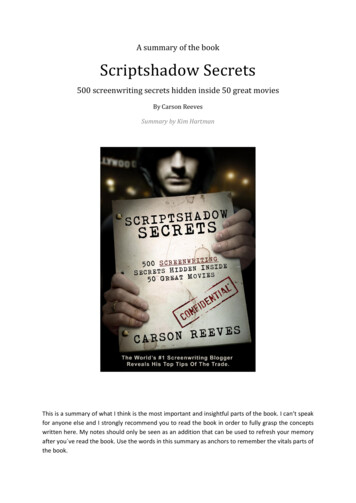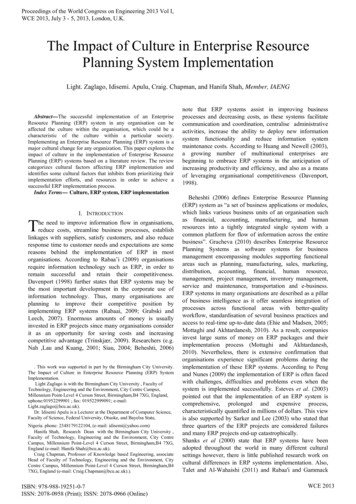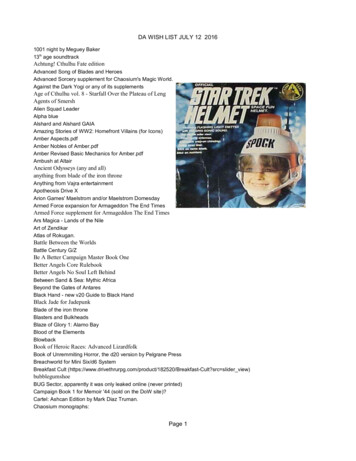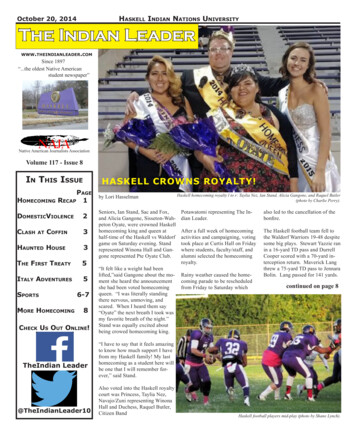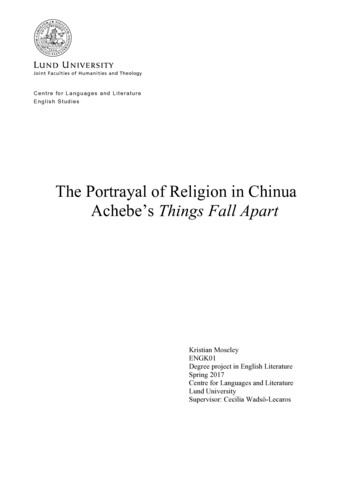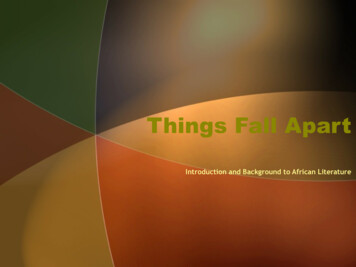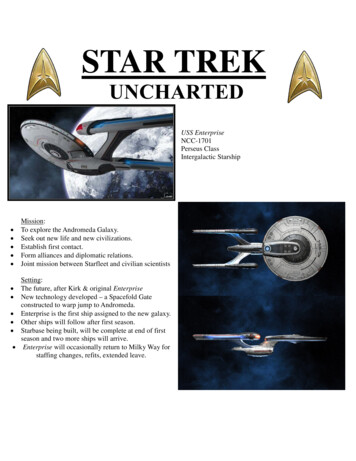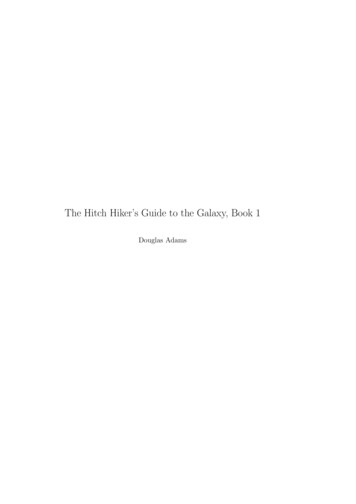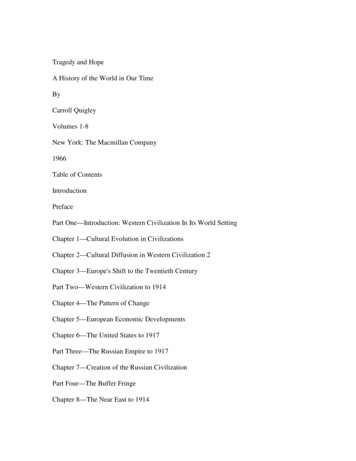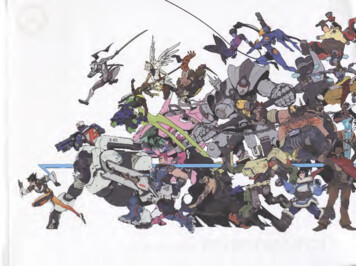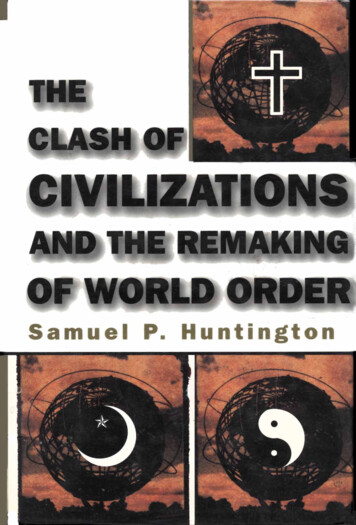
Transcription
meCLASH OFCIVILIZATIONSAND THE REMAKINGOF WORLD ORDERS a m u e l P. H u n t i n g t o n
U.S. 26.00Can. 35.00In the summer of 1993 Foreign Affairs publishedan article entitled "The Clash of Civilizations?"by Samuel Huntington. No article, according tothe editors of that distinguished journal, has gen erated more discussion since George Kennan's"X" article on containment in the 1940s. Now,Mr. Huntington expands on his article, exploresfurther the issues he raised then, and developsmany new penetrating and controversial analyses.In the article, he posed the question whether con flicts between civilizations would dominate thefuture of world politics. In the book, he gives hisanswer, showing not only how clashes betweencivilizations are the greatest threat to world peacebut also how an international order based on civi lizations is the best safeguard against war.Events in the past few years have confirmedMr. Huntington's earlier judgments. Increasingly,people define themselves on the basis of ancestry,language, religion, and customs. Today, in thepost-Cold War world, the critical distinctionsbetween people are not primarily ideological oreconomic; they are cultural. World politics isbeing reconfigured along cultural lines, with newpatterns of conflict and cooperation replacingthose of the Cold War. The hot spots in world pol itics are on the "fault lines" between civilizations:witness the fighting in Bosnia, Chechnya, theTranscaucasus, Central Asia, Kashmir, the MiddleEast, Tibet, Sri Lanka, Sudan, and many otherplaces.Mr. Huntington explains how the populationexplosion in Muslim countries and the economicrise of East Asia are changing global politics.These developments challenge Western domi nance, promote opposition to supposedly "univer sal" Western ideals, and intensify intercivilization(continuedon backflap)
(continuedfromfrontflap)conflict over such issues as nuclear proliferation,immigration, human rights, and democracy. TheMuslim population surge has led to many smallwars throughout Eurasia, and the rise of Chinacould lead to a global war of civilizations. Mr.Huntington sets forth a strategy for the West to pre serve its unique culture and emphasizes the needfor people everywhere to learn to coexist in a com plex, multipolar, multicivilizational world.The Clash of Civilizations and the Remaking ofWorld Order is an insightful and powerful analysisof the forces driving global politics today and intothe next century. It is sure to be one of the mosttalked about books of the decade.Samuel P. Huntington is Albert J. WeatherheadIII University Professor at Harvard University,where he is also director of the John M. OlinInstitute for Strategic Studies and chairman of theHarvard Academy for International and AreaStudies. He was director of security planning forthe National Security Council in the CarterAdministration, founder and co-editor of ForeignPolicy, and president of the American PoliticalScience Association. He is the author of manybooks and scholarly articles.VISIT US ON THE W O R L D WIDEhttp://www.simonsays.comWEBJACKET DESIGN BY MARC COHENJACKET PHOTOGRAPH BY PHOTONICA MELISSA HAYDENAUTHOR PHOTOGRAPH BY JANE REED/HARVARD UNIVERSITYPRINTED IN THE U.S.A. COPYRIGHT 1996 SIMON & SCHUSTER
"Spurred by modernization, global politics is being reconfigured alongcultural lines. Peoples and countries with similar cultures are comingtogether. Peoples and countries with different cultures are coming apart.Alignments defined by ideology and superpower relations are givingway to alignments defined by culture and civilization. Political bound aries are increasingly redrawn to coincide with cultural ones: ethnic,religious, and civilizational. Cultural communities are replacing GoldWar blocs, and the fault lines between civilizations are becoming thecentral lines of conflict in glqbal politics."—from The Clash of Civilizations and the Remaking of World Order1t SamHuntk ton, one of meflPest tjiost eminent political scientist; pre sents a challenging framework for understanding the realities of globalpalsies, fa the ne t c tury.The Clash of Civilizations and the Remaking1of World Order is olifie of the most important books to have emerged sincethe end of the Cold War."—Henry A. Kissinger"An intellectual tour de force: bold, imaginative, and provocative. A sem inal work that will revolutionize our understanding of internationalaffairs/'—Zbigniew BrzezinskilISBN D - b A 4 - A l l t M - 2ll bBSSD
Samuel P. Huntington
ClashCivilizationsRemakingWorld OrderSimon àf Schuster
SIMON 6- SCHUSTERRockefeller Center1230 Avenue of the AmericasNew York, NY 10020Copyright J 996 by Samuel P. HuntingtonAll rights reserved,including the right of reproductionin whole or in part in any form.SIMON & SCHUSTER and colophon are registered trademarksof Simon & Schuster Inc.Designed by Karolina HarrisManufactured in the United States of America3 5 7 9108 6 4 2Library of Congress Cataloging-in-Publication DataHuntington, Samuel P.The clash of civilizations and the remaking of world order ISamuel P. Huntington,p. cm.Includes index.1. World politics — 1989- 2. Post-communism.3. Civilization, Modem-1950I. Title.D860.H861996909.82'9-dc2096-31492CIPISBN 0-684-81164-2
To Nancy,who has endured "the clash" with a smile
ContentsList o f Illustrations: Tables, Figures, Maps11Preface13I. A World of Civilizations1. The New Era in World Politics 19INTRODUCTION: FLAGS AND CULTURAL IDENTITY 19A MULTIPOLAR, MULTICIVILIZATIONAL WORLD 21OTHER WORLDS? 29COMPARING WORLDS: REALISM, PARSIMONY, AND PREDICTIONS 362. Civilizations in History and Today 40THE NATURE OF CIVILIZATIONS 40RELATIONS AMONG CIVILIZATIONS 483. A Universal Civilization? Modernization and Westernization 56UNIVERSAL CIVILIZATION: MEANINGS 56UNIVERSAL CIVILIZATION: SOURCES 66THE WEST AND MODERNIZATION 68RESPONSES TO THE WEST AND MODERNIZATION 72II. The Shifting Balance of Civilizations4. The Fading of the West: Power, Culture, and Indigenization 81WESTERN POWER: DOMINANCE AND DECLINE 81INDIGENIZATION:THERESURGENCEOFNON-WESTERN CULTURES 91LA RE VANCHE DE DIEU95
8Contents5. Economies, Demography, and the Challenger Civilizations 102THE ASIAN AFFIRMATION 103THE ISLAMIC RESURGENCE 109CHANGING CHALLENGES 120III. The Emerging Order of Civilizations6. The Cultural Reconfiguration of Global Politics 125GROPING FOR GROUPINGS: THE POLITICS OF IDENTITY 125CULTURE AND ECONOMIC COOPERATION 130THE STRUCTURE OF CIVILIZATIONS 135TORN COUNTRIES: THE FAILURE OF CIVILIZATION SHIFTING 1397. Core States, Concentric Circles, and Civilizational Order 155CIVILIZATIONS AND ORDER 155BOUNDING THE WEST 157RUSSIA AND ITS NEAR ABROAD 163GREATER CHINA AND ITS CO-PROSPERITY SPHERE 168ISLAM: CONSCIOUSNESS WITHOUT COHESION 174IV. Clashes of Civilizations8. The West and the Rest: Intercivilizational Issues 183WESTERN UNIVERSALISM 183WEAPONS PROLIFERATION 186HUMAN RIGHTS AND DEMOCRACY 192IMMIGRATION 1989. The Global Politics of Civilizations 207CORE STATE AND FAULT LINE CONFLICTS 207ISLAM AND THE WEST 209ASIA, CHINA, AND AMERICA 218CIVILIZATIONS AND CORE STATES: EMERGING ALIGNMENTS 2381 0 . F r o m Transition Wars to Fault L i n e WarsTRANSITION WARS: AFGHANISTAN AND T H E G U L FCHARACTERISTICS OF F A U L T L I N E WARS246246252
Contents9INCIDENCE: ISLAM'S BLOODY BORDERS254CAUSES: H I S T O R Y , DEMOGRAPHY, P O L I T I C S25911. The Dynamics of Fault Line Wars 266IDENTITY: THE RISE OF CIVILIZATION CONSCIOUSNESS 266CIVILIZATION RALLYING: KIN COUNTRIES AND DIASPORAS 272HALTING FAULT LINE WARS 291V. The Future of Civilizations12. The West, Civilizations, and Civilization 301THE RENEWAL OF THE WEST? 301THE WEST IN THE WORLD 308C l V I L I Z A T I O N A L W A R AND O R D E R312T H E COMMONALITIES OF CIVILIZATION318Notes323Index353
List of IllustrationsTables2.1. Use o f Terms: "Free World" and "the West," p. 5 53.1. Speakers o f Major Languages, p. 6 03.2. S p e a k e r s o f P r i n c i p a l C h i n e s e a n d W e s t e r n L a n g u a g e s , p . 6 13.3. Proportion o f World Population A d h e r i n g to M a j o r ReligiousT r a d i t i o n s , p. 6 54 . 1 . T e r r i t o r y U n d e r t h e P o l i t i c a l C o n t r o l o f Civilizations, 1 9 0 0 – 1 9 9 3 ,p. 8 44.2. Populations o f Countries B e l o n g i n g to the World's M a j o rCivilizations, 1 9 9 3 , p. 8 54.3. Shares o f World Population U n d e r the Political Control o fCivilizations, 1 9 0 0 – 2 0 2 5 , p. 8 54 . 4 . S h a r e s o f W o r l d M a n u f a c t u r i n g O u t p u t by Civilization o r C o u n t r y ,1 7 5 0 – 1 9 8 0 , p. 8 64 . 5 . Civilization S h a r e s o f W o r l d G r o s s E c o n o m i c P r o d u c t ,p. 8 74.6. Civilization Shares of Total World Military Manpower, p. 885.1. Youth Bulge in Muslim Countries, p. 1198.1. Selected Chinese Arms Transfers, 1 9 8 0 – 1 9 9 1 , p. 1 8 98.2. U . S . P o p u l a t i o n by R a c e a n d E t h n i c i t y , p . 2 0 510.1. Ethnopolitical Conflicts, 1 9 9 3 – 1 9 9 4 , p. 2 5 810.2. E t h n i c Conflicts, 1 9 9 3 , p. 2 5 81 0 . 3 . Militarism o f M u s l i m a n d C h r i s t i a n C o u n t r i e s , p . 2 5 810.4. Possible Causes o f Muslim Conflict Propensity, p. 2 6 3Figures2 . 1 . E a s t e r n H e m i s p h e r e Civilizations, p . 4 93.1. Alternative Responses to the I m p a c t o f the West, p. 7 51950–1992,
List of12Illustrations3.2. Modernization a n d Cultural R e s u r g e n c e , p. 7 65 . 1 . T h e E c o n o m i c C h a l l e n g e : Asia a n d t h e West, p . 1 0 45 . 2 . T h e D e m o g r a p h i c C h a l l e n g e : I s l a m , Russia, a n d t h e West, p. 1 1 85 . 3 . M u s l i m Y o u t h B u l g e by R e g i o n , p. 1 2 09 . 1 . T h e G l o b a l P o l i t i c s o f Civilizations: E m e r g i n g A l i g n m e n t s , p . 2 4 51 0 . 1 . S r i L a n k a : S i n h a l e s e a n d T a m i l Y o u t h B u l g e s , p. 2 6 01 1 . 1 . T h e S t r u c t u r e o f a C o m p l e x F a u l t L i n e War, p. 2 7 4Maps1.1. T h e W e s t a n d t h e R e s t : 1 9 2 0 , p p . 2 2 - 2 31.2. T h e C o l d W a r W o r l d : 1 9 6 0 s , p p . 2 4 - 2 51.3. T h e W o r l d o f Civilizations: P o s t - 1 9 9 0 , p p . 2 6 - 2 77 . 1 . T h e E a s t e r n B o u n d a r y o f W e s t e r n Civilization, p. 1 5 97 . 2 . U k r a i n e : A Cleft C o u n t r y , p . 1 6 68 . 1 . T h e U n i t e d S t a t e s in 2 0 2 0 : A Cleft C o u n t r y ? p . 2 0 5
PrefaceIn the s u m m e r o f 1 9 9 3 the journal ForeignAffairspublished an article o f m i n etitled " T h e Clash o f Civilizations?". T h a t article, according to theAffairsForeigneditors, stirred up m o r e discussion in three years than any other articlethey had published since the 1940s. It certainly stirred up m o r e debate in threeyears than anything else I have written. T h e responses and c o m m e n t s on ithave c o m e from every c o n t i n e n t and scores o f countries. People were variouslyimpressed, intrigued, outraged, frightened, and perplexed by my argument thatthe central and most dangerous dimension o f the emerging global politicswould be conflict between groups from differing civilizations. W h a t e v e r else itdid, the article struck a nerve in people o f every civilization.Given the interest in, misrepresentation of, and controversy over the article,it seemed desirable for m e to explore further the issues it raised. O n e construc tive way o f posing a question is to state an hypothesis. T h e article, which had agenerally ignored question mark in its title, was an effort to do that. T h i s bookis intended to provide a fuller, deeper, and m o r e thoroughlydocumentedanswer to the article's question. I here attempt to elaborate, refine, supplement,and, on occasion, qualify the themes set forth in the article and to developmany ideas and cover many topics not dealt with or t o u c h e d on only in passingin the article. T h e s e include: the c o n c e p t o f civilizations; the question o f auniversal civilization; the relation between power and culture; the shiftingbalance o f power a m o n g civilizations; cultural indigenization in non-Westernsocieties; the political structure o f civilizations; conflicts generated by Westernuniversalism, M u s l i m militancy, and C h i n e s e assertion; balancing and bandwagoning responses to the rise o f C h i n e s e power; the causes and dynamics o ffault line wars; and the futures o f the West and o f a world o f civilizations. O n emajor t h e m e absent from the article c o n c e r n s the crucial impact o f populationgrowth on instability and the b a l a n c e o f power. A second important t h e m eabsent from the article is summarized in the book's title and final s e n t e n c e :"clashes o f civilizations are the greatest threat to world p e a c e , and an interna tional order based on civilizations is the surest safeguard against world war."T h i s book is not intended to be a work o f social science. It is instead m e a n tto be an interpretation o f the evolution o f global politics after the C o l d War. Itaspires to present a framework, a paradigm, for viewing global politics thatwill be meaningful to scholars and useful to policymakers. T h e test o f its
Preface14meaningfulness and usefulness is not whether it accounts for everything that ishappening in global politics. Obviously it does not. T h e test is whether itprovides a m o r e meaningful and useful lens through which to view interna tional developments than any alternative paradigm. In addition, no paradigmis eternally valid. W h i l e a civilizational approach may be helpful to understand ing global politics in the late twentieth and early twenty-first centuries, thisdoes not m e a n that it would have b e e n equally helpful in the mid-twentiethcentury or that it will be helpful in the mid-twenty-first century.T h e ideas that eventually b e c a m e the article and this book were first publiclyexpressed in a Bradley L e c t u r e at the A m e r i c a n Enterprise Institute in Washing ton in O c t o b e r 1 9 9 2 and then set forth in an O c c a s i o n a l Paper preparedfor the O l i n Institute's project on " T h e C h a n g i n g Security E n v i r o n m e n t andA m e r i c a n National Interests," m a d e possible by the Smith Richardson Founda tion. Following publication o f the article, I b e c a m e involved in innumerableseminars and meetings focused on "the clash" with a c a d e m i c , government,business, and other groups across the United States. In addition, I was fortunateto b e able to participate in discussions o f the article and its thesis in many othercountries, including Argentina, B e l g i u m , C h i n a , F r a n c e , G e r m a n y , G r e a t Brit ain, Korea, Japan, L u x e m b o u r g , Russia, Saudi Arabia, Singapore, South Africa,Spain, Sweden, Switzerland, and Taiwan. T h e s e discussions exposed m e toall the major civilizations except Hinduism, and I benefitted immenselyfrom the insights and perspectives o f the participants in these discussions. In1 9 9 4 and 1 9 9 5 I taught a seminar at Harvard on the nature o f the post-ColdW a r world, and the always vigorous and at times quite critical c o m m e n t s o fthe seminar students were an additional stimulus. M y work on this bookalso benefitted greatly from the collégial and supportive environment o fHarvard'sJohn M . OlinInstitutefor Strategic Studies andC e n t e r forInternational Affairs.T h e manuscript was read in its entirety by M i c h a e l C . D e s c h , Robert O .K e o h a n e , Fareed Zakaria, and R. Scott Z i m m e r m a n , and their c o m m e n t s ledto significant improvements in both its substance and organization. T h r o u g h out the writing o f this book, Scott Z i m m e r m a n also provided indispensableresearch assistance; without his energetic, expert, and devoted help, this bookwould never have b e e n c o m p l e t e d when it was. O u r undergraduate assistants,Peter Jun and Christiana Briggs, also pitched in constructively. G r a c e de M a gistris typed early portions o f the manuscript, and C a r o l Edwards with greatc o m m i t m e n t and superb efficiency redid the manuscript so many times thatshe must know large portions o f it almost by heart. D e n i s e S h a n n o n and LynnC o x at Georges Borchardt and Robert Asahina, Robert Bender, and Johanna Liat S i m o n & Schuster have cheerfully and professionally guided the manuscriptthrough the publication process. I a m i m m e n s e l y grateful to all these individu als for their help in bringing this book into being. T h e y have made it m u c hbetter than it would have b e e n otherwise, and the remaining deficiencies aremy responsibility.
PrefaceISM y work on this book was made possible by the financial support o f the J o h nM . O l i n Foundation and the S m i t h Richardson Foundation. W i t h o u t theirassistance, completion o f the book would have b e e n delayed for years, and Igreatly appreciate their generous backing o f this effort. W h i l e other foundationshave increasingly focused on domestic issues, O l i n and S m i t h Richardsondeserve accolades for maintaining their interest in and support for work on war,peace, and national and international security.S . P. H .
IWorldCivilizations
Chapter 1T h e New Era inWorld PoliticsINTRODUCTION: FLAGS AND CULTURAL IDENTITYn January 3, 1 9 9 2 a meeting o f Russian and A m e r i c a n scholars tookplace in the auditorium o f a government building in Moscow. T w oweeks earlier the Soviet U n i o n had ceased to exist and the RussianFederation had b e c o m e an independent country. As a result, thestatue o f L e n i n which previously graced the stage o f the auditorium had disap peared and instead the flag o f the Russian Federation was now displayed on thefront wall. T h e only problem, o n e A m e r i c a n observed, was that the flag hadb e e n hung upside down. After this was pointed out to the Russian hosts, theyquickly and quietly corrected the error during the first intermission.T h e years after the C o l d W a r witnessed the beginnings o f dramatic changesin peoples' identities and the symbols o f those identities. G l o b a l politics beganto be reconfigured along cultural lines. Upside-down flags were a sign o f thetransition, but more and m o r e the flags are flying high and true, and Russiansand other peoples are mobilizing and m a r c h i n g b e h i n d these and other sym bols o f their new cultural identities.O n April 18, 1 9 9 4 two thousand people rallied in Sarajevo waving the flagsof Saudi Arabia and Turkey. B y flying those banners, instead o f U.N., N A T O ,or American flags, these Sarajevans identified themselves with their fellowMuslims and told the world who were their real and not-so-real friends.O n O c t o b e r 16, 1 9 9 4 in Los Angeles 7 0 , 0 0 0 people m a r c h e d b e n e a t h "a seaof M e x i c a n flags" protesting Proposition 187, a referendum measure whichwould deny many state benefits to illegal immigrants and their children. W h yare they "walking down the street with a M e x i c a n flag and demanding that this
20The Clashof Civilizationsand the Remakingof WorldOrdercountry give t h e m a free education?" observers asked. " T h e y should be wavingthe A m e r i c a n flag." Two weeks later more protestors did march down the streetcarrying an A m e r i c a n flag —upside down. T h e s e flag displays ensured victoryfor Proposition 187, which was approved by 59 percent o f California voters.In the p o s t - C o l d W a r world flags c o u n t and so do other symbols o f culturalidentity, including crosses, crescents, and even head coverings, because culturecounts, and cultural identity is what is most meaningful to most people. Peopleare discovering new but often old identities and marching under new but oftenold flags which lead to wars with new but often old enemies.O n e grim Weltanschauungfor this new era was well expressed by the Vene tian nationalist demagogue in M i c h a e l Dibdin's novel, DeadLagoon:"Therec a n be no true friends without true enemies. Unless we hate what we are not,we c a n n o t love what we are. T h e s e are the old truths we are painfully redis covering after a century and m o r e o f sentimental cant. T h o s e who deny themdeny their family, their heritage, their culture, their birthright, their very selves!T h e y will not lightly b e forgiven." T h e unfortunate truth in these old truthsc a n n o t b e ignored by statesmen and scholars. For peoples seeking identity andreinventing ethnicity, e n e m i e s are essential, and the potentially most dangerousenmities o c c u r across the fault lines between the world's major civilizations.T h e central t h e m e o f this book is that culture and cultural identities, whichat the broadest level are civilization identities, are shaping the patterns o fcohesion, disintegration, and conflict in the p o s t - C o l d W a r world. T h e fiveparts o f this book elaborate corollaries to this main proposition.Part I: For the first time in history global politics is both multipolar andmulticivilizational; modernization is distinct from Westernization and is pro ducing neither a universal civilization in any meaningful sense nor the Western ization o f non-Western societies.Part II: T h e b a l a n c e o f power a m o n g civilizations is shifting: the West isdeclining in relative influence; Asian civilizations are expanding their eco n o m i c , military, and political strength; Islam is exploding demographically withdestabilizing c o n s e q u e n c e s for M u s l i m countries and their neighbors; andnon-Western civilizations generally are reaffirming the value o f their own cul tures.Part III: A civilization-based world order is emerging: societies sharing cul tural affinities cooperate with e a c h other; efforts to shift societies from o n ecivilization to another are unsuccessful; and countries group themselves aroundthe lead or core states o f their civilization.Part IV: T h e West's universalist pretensions increasingly bring it into conflictwith other civilizations, most seriously with Islam and C h i n a ; at the locallevel fault line wars, largely between Muslims and non-Muslims, generate"kin-country rallying," the threat o f broader escalation, and h e n c e efforts bycore states to halt these wars.Part V: T h e survival o f the West depends on Americans reaffirming theirWestern identity and Westerners accepting their civilization as unique not
The New Era in WorldPolitics21universal and uniting to renew and preserve it against challenges from nonWestern societies. Avoidance o f a global war o f civilizations depends on worldleaders accepting and cooperating to maintain the multicivilizational characterof global politics.A MULTIPOLAR, MULTICIVILIZATIONAL WORLDIn the p o s t - C o l d W a r world, for the first time in history, global politics hasb e c o m e multipolar and multicivilizational. During most o f h u m a n existence,contacts between civilizations were intermittent or nonexistent. T h e n , with thebeginning o f the modern era, about A.D. 1 5 0 0 , global politics assumed twodimensions. For over four hundred years, the nation states o f the West —Britain, F r a n c e , Spain, Austria, Prussia, G e r m a n y , the United States, and others— constituted a multipolar international system within Western civilization andinteracted, competed, and fought wars with e a c h other. At the same time,Western nations also expanded, conquered, colonized, or decisively influencedevery other civilization ( M a p 1.1). During the C o l d W a r global politics b e c a m ebipolar and the world was divided into three parts. A group o f mostly wealthyand democratic societies, led by the United States, was engaged in a pervasiveideological, political, e c o n o m i c , and, at times, military competition with agroup o f somewhat poorer communist societies associated with and led by theSoviet Union. M u c h o f this conflict occurred in the T h i r d World outside thesetwo camps, composed o f countries which often were poor, lacked politicalstability, were recently independent, and c l a i m e d to b e nonaligned ( M a p 1.2).In the late 1980s the c o m m u n i s t world collapsed, and the C o l d W a r interna tional system b e c a m e history. In the p o s t - C o l d W a r world, the most importantdistinctions a m o n g peoples are not ideological, political, or e c o n o m i c . T h e yare cultural. Peoples and nations are attempting to answer the most basicquestion h u m a n s can face: Who are we? And they are answering that questionin the traditional way h u m a n beings have answered it, by reference to thethings that m e a n most to them. People define themselves in terms o f ancestry,religion, language, history, values, customs, and institutions. T h e y identify withcultural groups: tribes, ethnic groups, religious c o m m u n i t i e s , nations, and, atthe broadest level, civilizations. People use politics not just to advance theirinterests but also to define their identity. W e know who we are only when weknow who we are not and often only when we know w h o m we are against.Nation states remain the principal actors in world affairs. T h e i r behavior isshaped as in the past by the pursuit o f power and wealth, but it is also shapedby cultural preferences, c o m m o n a l i t i e s , and differences. T h e most importantgroupings o f states are no longer the three blocs o f the C o l d W a r but rather theworld's seven or eight major civilizations ( M a p 1.3). Non-Western societies,particularly in East Asia, are developing their e c o n o m i c wealth and creatingthe basis for e n h a n c e d military power and political influence. As their powerand self-confidence increase, non-Western societies increasingly assert their
28The Clashof Civilizationsand the Remakingof WorldOrderown cultural values and reject those "imposed" on t h e m by the West. T h e"international system o f the twenty-first century," Henry Kissinger has noted,". . . will contain at least six major powers —the United States, Europe, C h i n a ,Japan, Russia, and probably India —as well as a multiplicity o f medium-sized1and smaller countries." Kissinger's six major powers belong to five very differ ent civilizations, and in addition there are important Islamic states whosestrategic locations, large populations, and/or oil resources make t h e m influen tial in world affairs. In this new world, local politics is the politics o f ethnicity;global politics is the politics o f civilizations. T h e rivalry o f the superpowers isreplaced by the clash o f civilizations.In this new world the most pervasive, important, and dangerous conflictswill not b e between social classes, rich and poor, or other economically definedgroups, but between peoples belonging to different cultural entities. Tribal warsand ethnic conflicts will o c c u r within civilizations. V i o l e n c e between statesand groups from different civilizations, however, carries with it the potential forescalation as other states and groups from these civilizations rally to the support2o f their "kin countries." T h e bloody clash o f clans in S o m a l i a poses no threato f broader conflict. T h e bloody clash o f tribes in Rwanda has consequences forUganda, Zaire, and Burundi but not m u c h further. T h e bloody clashes ofcivilizations in Bosnia, the Caucasus, Central Asia, or Kashmir could b e c o m ebigger wars. In the Yugoslav conflicts, Russia provided diplomatic support tothe Serbs, and Saudi Arabia, Turkey, Iran, and Libya provided funds and armsto the Bosnians, not for reasons o f ideology or power politics or e c o n o m i cinterest but b e c a u s e o f cultural kinship. "Cultural conflicts," Vaclav Havel hasobserved, "are increasing and are more dangerous today than at any time inhistory," and Jacques Delors agreed that "future conflicts will be sparked by3cultural factors rather than e c o n o m i c s or ideology." And the most dangerouscultural conflicts are those along the fault lines between civilizations.In the p o s t - C o l d W a r world, culture is both a divisive and a unifying force.People separated by ideology but united by culture c o m e together, as the twoG e r m a n y s did and as the two Koreas and the several C h i n a s are beginning to.Societies united by ideology or historical c i r c u m s t a n c e but divided by civiliza tion either c o m e apart, as did the Soviet Union, Yugoslavia, and Bosnia, or aresubjected to intense strain, as is the case with Ukraine, Nigeria, Sudan, India,Sri Lanka, and many others. Countries with cultural affinities cooperate eco nomically and politically. International organizations based on states with cul tural commonality, such as the E u r o p e a n U n i o n , are far more successful thanthose that attempt to transcend cultures. For forty-five years the Iron Curtainwas the central dividing line in E u r o p e . T h a t line has moved several hundredmiles east. It is now the line separating the peoples o f Western Christianity, onthe o n e hand, from M u s l i m and Orthodox peoples on the other.T h e philosophical assumptions, underlying values, social relations, customs,and overall outlooks on life differ significantly among civilizations. T h e revitalization o f religion throughout m u c h o f the world is reinforcing these cultural
The New Era in WorldPolitics29differences. Cultures c a n c h a n g e , and the nature o f their impact on politicsand e c o n o m i c s can vary from o n e period to another. Yet the major differencesin political and e c o n o m i c development a m o n g civilizations are clearly rootedin their different cultures. East Asian e c o n o m i c success has its source in EastAsian culture, as do the difficulties East Asian societies have had in achievingstable democratic political systems. Islamic culture explains in lar
4.2. Populations of Countries Belonging to the World's Major Civilizations, 1993, p. 85 4.3. Shares of World Population Under the Political Control of Civilizations, 1900–2025, p. 85 4.4. Shares of World Manufacturing Output by Civilization or Country, 1750–1980, p. 86 4.5. Civilization Shares of
